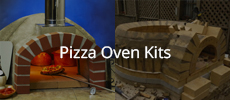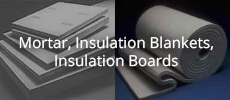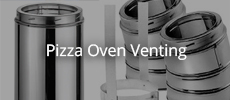What is your anticipated use of the oven, ie cook pizza one night then maybe roasting something the next day or multiple day cooking (3-5 days)? 2" ceramic blanket and 2" 8-10 p or vcrete will put you at the mid to higher end of heat retention. That is about what my oven has and and can cook easily 3 days worth, Pizza (700 F), then breads (500), then roasting (350 F).
Cant't say on walking in pcrete other than it has okay compressive strength, but poor abrasion and shear strength and depends on ratio
Announcement
Collapse
No announcement yet.
42" Pompeii construction in Adelaide
Collapse
X
-
G'day All,
Thanks Russell. I didn't initially plan to enclose a roof over the oven however I am now considering doing so. I will however proceed as if I'm not enclosing. I have allowed for 4-5" of blanket/pcrete/render. What would you recommend, 2" blanket and 2" pcrete ?? What do you think about lots of walking/standing on the surrounding pcrete? And if I may ask another, what would you say was the most height deviation acceptable in the concrete hearth before tiles and casil board. I have about 1/8" ??
Thanks Greenviews, howdy. Yes it would seem that walking on pcrete should be ok but I'm concerned the constant walking around the oven to build it would work away at the pcrete and crush it. As detailed, for me its simply to fill the area and will all be outside of the dome area. Also, this pcrete will be at the same height as the casil board, flush with the top, and serve to contain the edges of the board.
How much levelling of your hearth do you need to do? I'd have to check again but when checking for the low spots prior to drilling I don't think my slab deviation was much more than 1/8". I've read about levelling with sand and clay but I wonder how that would go allowing water to drain between the tiles, and would the tiles work their way into levelling compound. I guess if it set hard then that might work ??? I'm guessing the weight of the dome will push my casil board down in the low spots. I wasn't initially concerned but thinking about it now, if it takes a few courses of weight to push down, that could cause the floor to bend over a low spot and open up cracks ??
I'll go have a look at your build post, I assume it's here in "construction" ?
Whats your time line where you hope to finish?
I have some months away with work later this year. I'd be happy if I had the first fire early September and finished rendering in December. Chances are that could be December 2021 !!!!!
Many thanks and regards to all.
Leave a comment:
-
Do "not" add mortar to the 50/50 leveling sand/clay mix. You need the floor free floating. As far as the edge of the CaSi, I just parge the edge with leftover home brew as I started my brick courses. Just adds enough abrasion resistance to keep your toes from damaging the sides. PStoker, I cannot remember if you are enclosing the oven in a structure or not. If you are, you can put on 2" of ceramic blanket then dry fill the structure with perlite or vermiculite (fill in or blocking excess areas like corners) . If an open dome you can v or pcrete over the 2" of ceramic blanket then you have a more solid base for you final coatings.Last edited by UtahBeehiver; 06-08-2020, 03:36 PM.
- 1 like
Leave a comment:
-
Greetings! Looks like we are at the same stage of construction! I just drilled weep holse and layed tile then screen then 3" CaSi board down yesterday. Feel free to check out my build and I'll keep an eye on yours since we have many of the same questions. I was also considering mixing up some perlite mix to keep CaSi board in place and keep it from crumbling. I hope someone answers you, lol, but it seems much safer to me than keeping the very brittle board exposed. 5:1 is the ratio they suggest for insulating under floor, so if that ratio can take the weight of the dome on the edge, I would expect it to take a little foot traffic but I have no experience to bear yet. Regards! Big question I'm researching this morning is the mix to use to level my floor better. I'm considering either 1:1 fireclay:sand which I think I read somewhere and could add just a little mortar and a little lime if I want it to set faster. Or I could use some of my refractory mortar, but I'm not sure that is the best for this. Still searching the forum.
I just drilled weep holse and layed tile then screen then 3" CaSi board down yesterday. Feel free to check out my build and I'll keep an eye on yours since we have many of the same questions. I was also considering mixing up some perlite mix to keep CaSi board in place and keep it from crumbling. I hope someone answers you, lol, but it seems much safer to me than keeping the very brittle board exposed. 5:1 is the ratio they suggest for insulating under floor, so if that ratio can take the weight of the dome on the edge, I would expect it to take a little foot traffic but I have no experience to bear yet. Regards! Big question I'm researching this morning is the mix to use to level my floor better. I'm considering either 1:1 fireclay:sand which I think I read somewhere and could add just a little mortar and a little lime if I want it to set faster. Or I could use some of my refractory mortar, but I'm not sure that is the best for this. Still searching the forum.
Leave a comment:
-
G'day All,
Drilled drain holes in the hearth today. Looks a bit random in the photo's but they are located in the lower area's, and I attempted to clear the steel mesh (which is 4 inch square), and also position between tile location. I thought drilling would be easier than pipes in the concrete as I used a long post with a spacer below to set the concrete height, screeding across the top of the bricks, little pipes would have made this almost impossible. I ended up hitting the steel mesh in 5 holes and filled them with silicone, re-drilling 4 of them. If doing this again I would mark where the mesh was to avoid hitting them.
All 3 layers of the Calsil board are cut ready so now to the oven floor bricks, and the perlite around the edges.
I did have a few questions in the previous post, possible a little long winded, so I'll condense them down.
As seen in photo 3 I have a large area either side of the oven, granite slabs will be on top. The oven will sit on calsil board and I thought to put perlite (5;1) around the edges, up to the calsil board, flush with the top. This is simply to fill the area. I will need to walk on the perlite to build the oven, can it take foot traffic without crushing?
I've searched and 3 " seems to be the minimum dome insulation blanket. I'd like more than minimum and I've gone 3 " calsil under the oven, any recommendations for blanket thickness? Also, whats the normal thickness on the blanket, mortar or similar and render??
Many thanks
- 1 like
Leave a comment:
-
G'day All,
More progress today, worked on the position of the oven on the hearth (pictured last post) and cut all three layers of the calsil board, one inch each layer. I have a few questions though for anyone with time;
The 3 inch of calsil board on top of mosaic tiles will be flush with the top of the brick layer. I then need to fill the surrounding space as I intend to lay 30mm (1.2 inch) granite slabs around the oven on top of the filling I am asking about. I plan to use perlite or vermiculite simply because its light and easy to work with, at a 5;1 ratio. Question is can that ratio of vermiculite be walked on without crushing it? Ill need to be up there walking around to make the oven as its a large area??
I have prepared 75mm (3 inch) of calsil board to have under the oven floor, so hopefully sorted there. For the dome insulation I note reading posts that 3 inch is the minimum recommended around the dome. What thickness of blanket will match and compliment the 3 inch underfloor insulation? I assume more than the minimum?????
If using blanket insulation around the dome, whats recommended for rendering? I assume we would need a layer of concrete or mortar or something, and how thick before applying render?
And lastly, and thanks for reading. On top of my insulation, (boards for oven and perlite around sides at the same level) I will use a 50 mm ( 2 inch) floor brick/paver for the oven, and surrounding that a 30mm (1.2 inch) granite slab. So at some stage I need to transition from the 50mm height to the 30mm. I could run the oven floor bricks to the front of the structure, some 4-5 inches past the end of the entry and have the little step down to the granite to each of the sides. Alternatively, I'm thinking of having the entry bricks cut to be the width of the inside of the entry arch and grinding/cutting them so over the length of the entry they reduce down to 30mm and meet the strip of granite running along the front edge at the same height. What do you think? Have you seen this?
Thanks for reading and I appreciate and time for replies.
Regards
Leave a comment:
-
G'day All,
Well I've finally laid the structural slab/hearth. Ended up about 90mm or a little over 3.5 inch thick but its 40mpa concrete and F61 mesh which is 6mm (1/4) inch wire with 100mm centres (4 inches).
Initially the plan was simply to have a similar thickness slab and top off flush with the top of the outer row of bricks with perlite. In the end after so many posts talked about wishing they used more insulation I've decided to put 3 layers of calsil board on the hearth, 75 mm (3 inch) and the oven floor directly on that. I will go with the mosaic tile layer under the board and drill holes in the slab option as well.
Quite a few considerations crept in regarding the way I'm building. The idea is the bricks rise up to the top, concealing the hearth edge, and match the house. The large top surface will be finished with granite slabs. Expansion of hearth caused some concern given it's so long, not when using the oven, but ambient temps here range from 0-48 deg c (32-118 deg F) so that will cause more of a temp range that using the oven. Even a 30 deg c range could cause in excess of 2 mm of expansion and that would cause the edge bricks to crack away. Expansion joint foam was a simple solution to minimise the risk of cracking the outer bricks.
What I didn't really find a solution for was expansion pushing the surfaces the slab rests on, simply the inner walls of the double brick. I ended up bending up some thin sheet metal angle to provide a smooth surface and the slab isn't and lower, meaning there is no edge to push out. Hopefully if the slab does expand it will do so over the sheet metal angles and not move the bricks.
Additionally a friend who does a bit of concreting was super concerned the concrete could push the bricks out when laying it in, whilst wet, hence the supports around the outside.
Regards
Leave a comment:
-
A tapered inner arch is one of the most difficult concepts to visualize. So I have attached a couple pics.
1. looks like the bottom of the arch form is too far in. The edge should sit right on the arch of the dome.
2. The arch bricks need to be "FULL" length bricks not half bricks. See pic.
3. Can't see the mounting end to clearly but it appears to be raised off the floor elevation by an 1" or so. This affects the inner arch dimension, ie if the radius at the floor is 18" then the radius at the TDC will be 18" plus a portion of the height of the IT off the floor.
4. Each Tapered arch brick is different so don't cut them all the same. Use the IT and the previously cut brick to lay out the next one
5. Brick bracket? Remember that the centerline from the pivot point to the centerline of the brick bracket must intersect the halfway point on the horizontal thickness of the brick. IE if brick is 2.5" thick. bracket center through to pivot point needs to be at 1.25"
Last edited by UtahBeehiver; 05-08-2020, 07:37 AM.
Leave a comment:
-
G'day All,
Hope all is well. I think I need a little assistance if you can.
At one stage I thought I had the tapered inner arch sorted but now I'm convinced I don't. I'm Happy to exchange, what about a fully adjustable IT tool, LOL. Machining on the lathe, thread-cutting and welding to make the IT tool no problems. I can't get the bloody IT tool in my head though.
The first photo shows where the lower most brick of the inner, appears to need be in relation to the dome. Further back appears not possible. I would like to use half bricks for the inner arch to allow vent arch length.
The second photo is the upper inner arch TDC when aligned with the lower brick position. As far as I know all the bricks of the inner arch should be aligned?
Question is, seems to me that the lower arch brick cannot go back and looks like the upper arch TDC needs to move back to engage properly with the dome?? This won't work if they remain in the same plane?
Advice very much welcomed.
Regards
Greg
Leave a comment:
-
G'day All,
Thanks Catch, the saw blade is around 350mm or 13.5 inch. The blade looks to have around half life remaining which is a bonus. It cost me around $300 to rebuild which I think is ok. I can't see hiring a saw would work unless you could cut most bricks at once, which I cannot do. Cutting the arch and other tricky bits will surely be easier having your own saw given you can do it slowly when your ready. Shit I've had a real struggle getting my head around the arch radius shape as well as the taper method so cutting anything like that up front is not possible.
Mikie V , thanks for the reply. I read your build again (also read a month or two ago) but this time I think I actually understood your questions and therefore could understand the answers. You are right for sure that I had the same questions, with the main issue, how far in or out of the dome for the inner arch, and exactly the point, it needs to be positioned so it is ok at the TDC as well as the very bottom. I was on the right track but I now think the key thing is to get the inner arch form built, and sit TDC in place. Part of my problem was how to draw the inner arch with an upper radius, height at 12" and side radius of 9.5" ( 19" wide opening). Anyway I'll sit that bottom arch brick on the oven floor, thereby raising the radius centre. If I draw the arc at that raised point the overall opening will be 12.2" high and still 19" wide.
I'm still a little unsure, any thoughts on the Mosaic tiles under the calsil board, is 5-6 mm (3/16 inch) is thick enough? Also, has anyone used a stainless entryway floor? I'm thinking floor bricks to the outer edge of the inner arch, some sort of heat break, in the floor and to the vent arch with the floor being a stainless plate??
Time to crack out the new jigsaw.
Regards
Greg
Leave a comment:
-
Couple things... I had all the same questions you did and I think they were answered pretty well on my thread. I will say that I was concerned with putting the cut face inside toward the fire. I did one chain that way for looks only. I don’t think it matters.
You will figure out that reach of the inner arch, I promise. I never thought I’d figure it out but with the help of several members I felt confident and it worked out. I was skeptical but went for it... use the IT to figure the TDC brick and work down from there. I made it way more complicated than it needed to be.
Mikie V
Leave a comment:
-
Now that's what I'm talking about. Nice score on the saw! What's the diameter of the blade on that bad boy!
Ricky
- 1 like
Leave a comment:
-
G'day All, time for a progress post, and couple of questions for anyone with time.
I've read it a thousand times and am now experiencing it for myself, little forward with plenty of going backwards as well (hopefully less though).
Finished the IT tool today and cut the first bricks yesterday. The brick saw was given to me and needed HEAPS of cleaning and a full rebuild. The case crack and subsequent oil leak mentioned above is holding together for now.
Chasing info on;
1 Is it important which way the half bricks for the dome sit, ie, cut inside or outside. I'm not sure if the kiln fired original uncut side should be facing inside towards the heat?
2 I'm laying mosaic tiles under the calsil board, Is 5-6 mm (3/16 inch) is thick enough. Seems thin but to go thicker they become stone and super $$$$
3 Any tips on how to draw an arch opening, so I can copy to plywood for the template? I'm going for 12" high and 19" wide which seems fairly standard but with a width radius of 9 and half inch and height of 12" its got me wondering how to draw it and subsequently shape it?
4 And finally, the arch position, back and forward relative to the dome is causing me grief, doing my head in. I've saved heaps of photo's and spent hours looking at this and I "think" I've got it but I'm not 100%. See in the photo, the top brick up on it's side is at the correct height in relation to the IT tool, and that's a little marker in the holder. The outer most end face of that top brick is just inside the outer dome radius, at floor level. Obviously, that top arch brick position governs the lower most arch brick. Have I got it right
Many thanks for the thoughts and comments, greatly appreciated.
Kind Regards
Leave a comment:
-
G'day All, I did ask in another post with nil responses in relation but is anyone fitting temp probes when building ovens these days? The infrared temp hand gun probes are not too expensive and can quickly measure temp of any surface. I assume when checking oven temps one could do so in a few consistent positions thereby reproducing temp readings from those same area's and getting to know what works, from one use to the next. Thoughts/recommendations appreciated.
Kind regards
Greg
Leave a comment:
-
Just to make sure, none of the bricks in holes in it are being used in the dome or floor. I do not think you need the half white brick next to the red half brick.
Leave a comment:





Leave a comment: